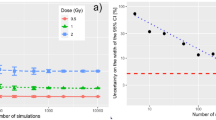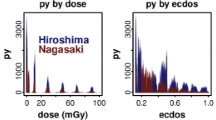Abstract
Radiation-related risks of cancer can be transported from one population to another population at risk, for the purpose of calculating lifetime risks from radiation exposure. Transfer via excess relative risks (ERR) or excess absolute risks (EAR) or a mixture of both (i.e., from the life span study (LSS) of Japanese atomic bomb survivors) has been done in the past based on qualitative weighting. Consequently, the values of the weights applied and the method of application of the weights (i.e., as additive or geometric weighted means) have varied both between reports produced at different times by the same regulatory body and also between reports produced at similar times by different regulatory bodies. Since the gender and age patterns are often markedly different between EAR and ERR models, it is useful to have an evidence-based method for determining the relative goodness of fit of such models to the data. This paper identifies a method, using Akaike model weights, which could aid expert judgment and be applied to help to achieve consistency of approach and quantitative evidence-based results in future health risk assessments. The results of applying this method to recent LSS cancer incidence models are that the relative EAR weighting by cancer solid cancer site, on a scale of 0–1, is zero for breast and colon, 0.02 for all solid, 0.03 for lung, 0.08 for liver, 0.15 for thyroid, 0.18 for bladder and 0.93 for stomach. The EAR weighting for female breast cancer increases from 0 to 0.3, if a generally observed change in the trend between female age-specific breast cancer incidence rates and attained age, associated with menopause, is accounted for in the EAR model. Application of this method to preferred models from a study of multi-model inference from many models fitted to the LSS leukemia mortality data, results in an EAR weighting of 0. From these results it can be seen that lifetime risk transfer is most highly weighted by EAR only for stomach cancer. However, the generalization and interpretation of radiation effect estimates based on the LSS cancer data, when projected to other populations, are particularly uncertain if considerable differences exist between site-specific baseline rates in the LSS and the other populations of interest. Definitive conclusions, regarding the appropriate method for transporting cancer risks, are limited by a lack of knowledge in several areas including unknown factors and uncertainties in biological mechanisms and genetic and environmental risk factors for carcinogenesis; uncertainties in radiation dosimetry; and insufficient statistical power and/or incomplete follow-up in data from radio-epidemiological studies.
Similar content being viewed by others
References
Akaike H (1973) Information theory and an extension of the maximum likelihood principle. In: Petrov BN, Caski F (eds) Proceedings of the second international symposium on information theory. Akademiai Kiado, Budapest, pp 267–281
Akaike H (1974) A new look at the statistical model identification. IEEE Trans Autom Control 19(6):716–723
Arisawa K, Soda M, Shirahama S, Saito H, Takamura N, Yamaguchi M, Odagiri K, Nakagoe T, Suyama A, Doi H (2002) Geographic distribution of the incidence of adult T-cell leukemia/lymphoma and other malignancies in Nagasaki Prefecture, Japan. Jpn J Clin Oncol 32:301–306
Burnham KP, Anderson DR (1998) Model selection and inference: a practical information-theoretic approach. Springer, New York
Burnham KP, Anderson DR (2002) Model selection and multimodel inference, 2nd edn. Springer, New York
Burnham KP, Anderson DR (2004) Multimodel inference. Understanding AIC and BIC in model selection. Sociol Methods Res 33(2):261–304, see also Workshop on model selection, Amsterdam http://www2.fmg.uva.nl/modelselection/ (Accessed Nov 2011)
Chatfield C (1995) Model uncertainty, data mining and statistical inference (with discussion). J R Stat Soc Series A 158:419–466
Claeskens G, Hjort NL (2008) Model selection and model averaging. Cambridge University Press, Cambridge
Clemmesen J (1948) Carcinoma of the breast. Br J Radiol 21(252):583–590
Curtis C, Shah SP, Chin SF, Gulisa Turashvili G, Rueda OM, Dunning MJ, Speed D, Lynch AG, Samarajiwa S, Yuan Y, Gräf S, Gavin H, Haffari G, Bashashati A, Russell R, McKinney S, METABRIC Group, Langerød A, Green A, Provenzano E, Wishart G, Pinder S, Watson P, Markowetz F, Murphy L, Ellis I, Purushotham A, Børresen-Dale AL, Brenton JD, Tavare S, Caldas C, Aparicio S (2012) The genomic and transcriptomic architecture of 2,000 breast tumours reveals novel subgroups. Nature. doi:10.1038/nature10983
de Martel C, Ferlay J, Franceschi S, Vignat J, Bray F, Forman D, Plummer M (2012) Global burden of cancers attributable to infections in 2008: a review and synthetic analysis. The Lancet Oncology, Early Online Publication, doi:10.1016/S1470-2045(12)70137-7
EPA (1994) (Environmental Protection Agency). Estimating radiogenic cancer risks. EPA Report 402-R-93-076, Washington, DC: US EPA
EPA (2011) Radiogenic cancer risk models and projections for the US population, EPA 402-R-11-001, US. Environmental protection agency office of radiation and indoor air Washington, DC 20460
Furukawa K, Preston DL, Lonn S, Funamoto S, Yonehara S, Matsuo T, Egawa H, Tokuoka S, Ozasa K, Kasagi F, Kodama K, Mabuchi K (2010) Radiation and smoking effects on lung cancer incidence among atomic bomb survivors. Radiat Res 174:72–82
Hoeting JA, Madigan D, Raftery AE, Volinsky CT (1999) Bayesian model averaging: a tutorial. Stat Sci 14(4):382–417
International Commission on Radiological Protection (2007) The 2007 recommendations of the international commission on radiological protection. ICRP_103. Ann ICRP 7:2–4
Jacob P, Bogdanova TI, Buglova E, Chepurniy M, Demidchik Y, Gavrilin Y, Kenigsberg J, Meckbach R, Schotola C, Shinkarev S, Tronko MD, Ulanovski A, Vavilov S, Walsh L (2006) Thyroid cancer risk in areas of Ukraine and Belarus affected by the chernobyl accident. Radiat Res 165:1–8
Kaiser JC, Walsh L (2012) Independent analysis of the radiation risk for leukaemia in children and adults with mortality data (1950–2003) of the Japanese A-bomb survivors. Radiat Environ Biophys (accepted). doi:10.1007/s00411-012-0437-6
Kaiser JC, Jacob P, Meckbach R, Cullings HM (2012) Breast cancer risk in atomic bomb survivors from multi-model inference with incidence data 1958–1998. Radiat Environ Biophys 51:1–14
Kellerer AM, Nekolla E, Walsh L (2001) On the conversion of solid cancer excess relative risk into lifetime attributable risk. Radiat Environ Biophys 40:249–257
Kellerer AM, Walsh L, Nekolla EA (2002) Risk coefficient for γ-rays with regard to solid cancer. Radiat Environ Biophys 41:113–123
Likhtarov L, Kovgan L, Vavilov S, Chepurny M, Ron E, Lubin J, Bouville A, Tronko N, Bogdanova T (2006) Post-chornobyl thyroid cancers in Ukraine, Report 2: risk analysis. Radiat Res 166:375–386
Little MP (2008) Leukemia following childhood radiation exposure in the Japanese atomic bomb survivors and in medically exposed groups. Radiat Prot Dosim 132(2):156–165
Little MP, Boice JD Jr (1999) Comparison of breast cancer incidence in the Massachusetts tuberculosis fluoroscopy cohort and in the Japanese atomic bomb survivors. Radiat Res 151:218–224
Little MP, Weiss HA, Boice JD Jr, Darby SC, Day NE, Muirhead CR (1999) Risks of leukemia in Japanese atomic bomb survivors, in women treated for cervical cancer, and in patients treated for ankylosing spondylitis. Radiat Res 152:280–292
Little MP, Hoel DG, Molitor J, Boice JD Jr, Wakeford R, Muirhead CR (2008) New models for evaluation of radiation-induced lifetime cancer risk and its uncertainty employed in the UNSCEAR 2006 report. Radiat Res 169:660–676
Ozasa K, Shimizu Y, Suyama A, Kasagi F, Soda M, Grant EJ, Sakata R, Sugiyama H, Kodama K (2012) Studies of the mortality of atomic bomb survivors, report 14, 1950–2003: an overview of cancer and noncancer diseases. Radiat Res 177(3):229–243
Pawel DJ, Puskin JS (2012) U.S. Environmental protection agency radiogenic risk models and projections for the U.S. population. Health Phys 102(6):646–656
Pierce DA, Shimizu Y, Preston DL, Vaeth M, Mabuchi K (1996) Studies of the mortality of atomic bomb survivors. report 12, Part I. Cancer: 1950–1990. Radiat Res 146:1–27
Pierce DA, Sharp GB, Mabuchi K (2003) Joint effects of radiation and smoking on lung cancer risk among atomic bomb survivors. Radiat Res 159:511–520
Posada D, Buckley TR (2004) Model selection and model averaging in phylogenetics: advantages of Akaike Information Criterion and Bayesian approaches over likelihood ratio tests. Syst Biol 53(5):793–808
Preston DL, Lubin JH, Pierce DA (1993) Epicure user’s guide. HiroSoft International Corp, Seattle
Preston DL, Mattsson A, Holmberg E, Shore R, Hildreth NG, Boice JD (2002) Radiation effects on breast cancer risk: a pooled analysis of eight cohorts. Radiat Res 158:220–235
Preston DL, Shimizu Y, Pierce DA, Suyama A, Mabuchi K (2003) Studies of the mortality of atomic bomb survivors. Report 13: solid cancer and noncancer disease mortality: 1950–1997. Radiat Res 160:381–407
Preston DL, Pierce DA, Shimizu Y, Cullings HM, Fujita S, Funamoto S, Kodama K (2004) Effects of recent changes in atomic bomb survivors dosimetry on cancer mortality risk estimates. Radiat Res 162:377–389
Preston DL, Ron E, Tokuoka S, Funamoto S, Nishi N, Soda M, Mabuchi K, Kodama K (2007) Solid cancer incidence in atomic bomb survivors: 1958–1998. Radiat Res 168:1–64
Ron E, Lubin JH, Shore RE, Mabuchi K, Modan B, Pottern LM, Schneider AB, Tucker MA, Boice JD Jr (1995) Thyroid cancer after exposure to external radiation: a pooled analysis of seven studies. Radiat Res 141:259–277
Thompson DE, Mabuchi K, Ron E, Soda M, Tokunaga S, Ochikubo S, Sugimoto S, Ikeda T, Terasaki M (1994) Cancer incidence in atomic bomb survivors. Part II: solid tumors,1958–1987. Radiat Res 137(Suppl):S17–S67
United Nations (2006) Effects of ionizing radiation. United Nations scientific committee on the effects of atomic radiation UNSCEAR 2006 Report. Volume I. Annex A: Epidemiological studies of radiation and cancer. United Nations, New York, 2008
United States National Research Council, Committee to Assess Health Risks from Exposure to Low Levels of Ionizing Radiation (1990) Health effects of exposure to low levels of ionizing radiation: BEIR V. United States National Academy of Sciences. National Academy Press, Washington
United States National Research Council, Committee to Assess Health Risks from Exposure to Low Levels of Ionizing Radiation (2006) Health risks from exposure to low levels of ionizing radiation: BEIR VII—Phase 2. United States National Academy of Sciences. National Academy Press, Washington
Vaeth M, Pierce D (1990) Calculating lifetime risk in relative risk models. Environ Health Perspect 87:83–94
Walsh L (2007) A short review of model selection techniques for radiation epidemiology. Radiat Environ Biophys 46:205–213
Walsh L, Kaiser JC (2011) Multi-model inference of adult and childhood leukaemia excess relative risks based on the Japanese A-bomb survivors mortality data (1950–2000). Radiat Environ Biophys 50:21–35
Acknowledgments
Dr. Walsh would like to thank Prof. Richard Wakeford (University of Manchester, U.K.) for drawing her attention to the current situation regarding the subjective nature of the weighting of ERR and EAR models for the calculation of lifetime risks of cancer from radiation exposure. The authors would also like to thank Prof. Donald A. Pierce, Dr. Elke A. Nekolla, Dr Charles Land, Dr. Roy Shore, Dr Michaela Kreuzer, Dr. Jan C. Kaiser and Dr. Peter Jacob for useful discussions. They would also like to thank two anonymous reviewers for their careful considerations and for providing many interesting points for the discussion section. This work was partly supported by the seventh framework program of the European Union, FP-7-EU-ANDANTE (Multidisciplinary evaluation of the cancer risk from neutrons relative to photons using stem cells and the analysis of second malignant neoplasms following paediatric radiation therapy). This work makes use of the data obtained from the Radiation Effects Research Foundation (RERF) in Hiroshima, Japan. RERF is a private foundation funded equally by the Japanese Ministry of Health and Welfare and the US Department of Energy through the US National Academy of Sciences. The conclusions in this work are those of the authors and do not necessarily reflect the scientific judgement of RERF or its funding agencies.
Author information
Authors and Affiliations
Corresponding author
Rights and permissions
About this article
Cite this article
Walsh, L., Schneider, U. A method for determining weights for excess relative risk and excess absolute risk when applied in the calculation of lifetime risk of cancer from radiation exposure. Radiat Environ Biophys 52, 135–145 (2013). https://doi.org/10.1007/s00411-012-0441-x
Received:
Accepted:
Published:
Issue Date:
DOI: https://doi.org/10.1007/s00411-012-0441-x




